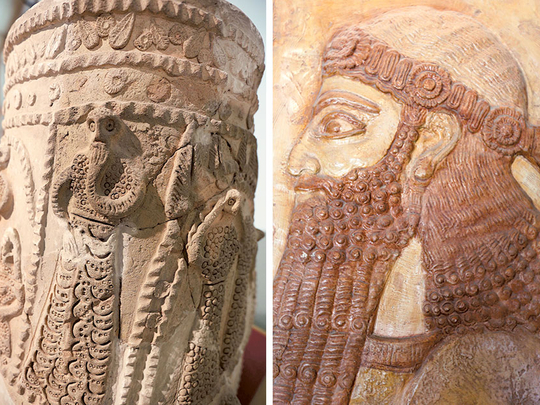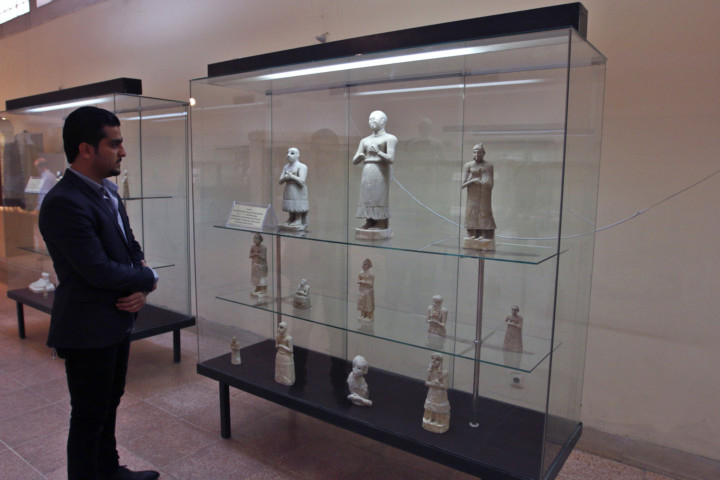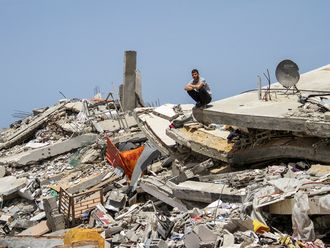
Baghdad: In those areas of Iraq and Syria controlled by Daesh, residents are furtively recording on their cellphones damage done to antiquities by the extremist group. In northern Syria, museum curators have covered precious mosaics with sealant and sandbags.
And at Baghdad’s recently reopened National Museum of Iraq, new iron bars protect galleries of ancient artifacts from the worst-case scenario.
These are just a few of the continuing efforts to guard the treasures of Iraq and Syria, two countries rich with traces of the world’s earliest civilizations. Yet only so much can be done under fire, and time is running out as Daesh militants speed ahead with the systematic looting and destruction of antiquities.
The group has already destroyed parts of two of northern Iraq’s most prized ancient cities, Nimrud and Hatra. On March 8, residents said militants destroyed parts of Dur Sharrukin, a 2,800-year-old Assyrian site near the village of Khorsabad.
Daesh militants have called ancient art idolatry that must be destroyed. But they also loot antiquities on a large scale to raise money, according to officials and experts who track the thefts through local informants and satellite imagery.
Archaeologists and preservationists, used to battling mundane enemies like weather and development, lament that in areas held by Daesh there is little they can do but document the destruction.
“A fool criminal can come with one hit of a hammer and destroy all our efforts, and we can do nothing,” said Qais Hussain Rashid, deputy minister for tourism and antiquities. “It’s a great grief.”
Some have even called for air strikes, not the usual province of Iraq’s cultural elite. Rashid and his boss, the minister, Adel Shirshab, both called for US-led coalition warplanes to strike militants approaching other historic sites.
Now, Iraq’s cultural institutions are “on the front lines against terrorism,” Shirshab said, fighting a “barbarian invasion that is targeting our heritage.”
But Iraq, he said, has survived “many invaders.”
He was not referring only to Hulagu Khan, the Mongol conqueror who razed the world’s greatest library and some of its finest buildings when he sacked Baghdad in 1258.
There was also the US invasion in 2003, when US troops stood by as looters ransacked the Baghdad museum, a scenario that, Shirshab suggested, is being repeated today. He spoke as Jeff Allen, a programme director at the World Monuments Fund, ceremonially handed over a thick set of plans, produced with Iraqi conservators, for the preservation of the Babylon site.
The document addresses challenges that have long threatened Babylon: from brick thieves to railroad and pipeline construction.
Luckily, Babylon and other sites like the ziggurat of Ur are south of Baghdad, where the national government is more firmly in control. Only the military can keep those sites safe, said Hadi Moussa, an employee at the Babylon site.
“This is Hulagu,” he said comparing the modern invaders to an ancient one. But he added that an inscription on Babylon’s gate dedicated to the goddess Ishtar read: “Ishtar will defeat her enemies.”
The Babylon preservation plan also includes new documentation of the site, including brick-by-brick scale drawings of the ruins. In the event the site is destroyed, Allen said, the drawings can be used to rebuild it.
But there are no equivalent drawings of Hatra and Nineveh. After years of neglect and sanctions during Saddam Hussain’s dictatorship, and the political chaos after his downfall, Iraq was behind international standards in cataloging antiquities and archaeological sites, a process that can help retrieve stolen objects or restore damaged ones.
The US invasion alerted archaeologists to what needed protecting. After damage and looting at many sites, documentation and preservation accelerated. One result was that the Mosul Museum, attacked by Daesh, had been digitally cataloged. Items not seen destroyed on video were presumed looted, and a list has been passed to law enforcement, said Katharyn Hanson, an University of Pennsylvania archaeology fellow working with the consortium.
Around 2005 in Syria, Azm helped start similar projects amid fears that country would face the next US invasion. But the work was never finished, said Azm, who now opposes the Syrian government and teaches at Shawnee University in Ohio.
He oversees an informal team of Syrians he has nicknamed the Monuments Men, many of them his former students. They document damage and looting by Daesh, pushing for crackdowns on the black market. Recently, the United Nations banned all trade in Syrian artifacts.
Azm also worked with curators at the Ma’arra Mosaics Museum in Ma’arrat an Nu’man in the northern Syrian province of Idlib, who, in what so far is a rare success story, have safeguarded the mosaics there.
The preservation consortium trained and financed the curators who sealed the mosaics and barricaded them behind sandbags - not sturdy enough to withstand a direct hit, but a measure of protection and a barrier to thieves.














